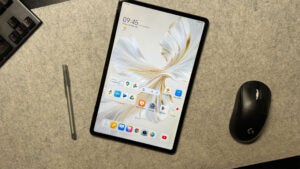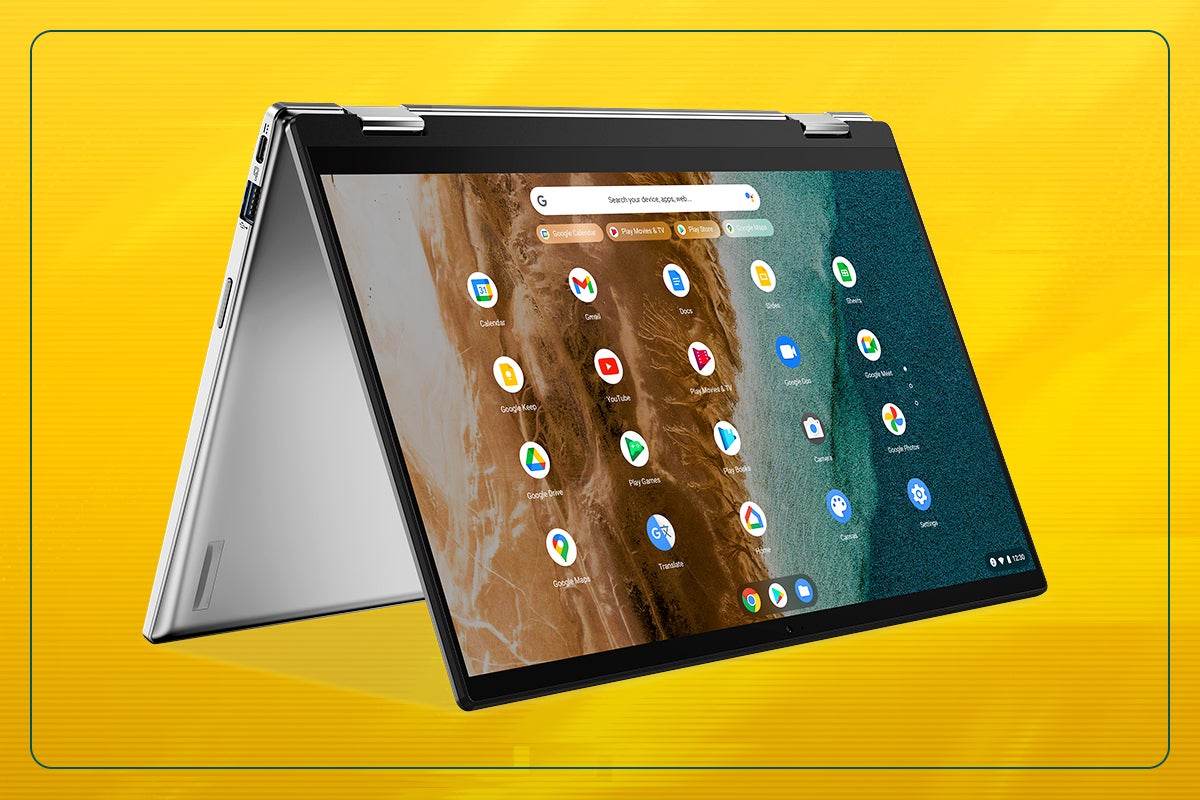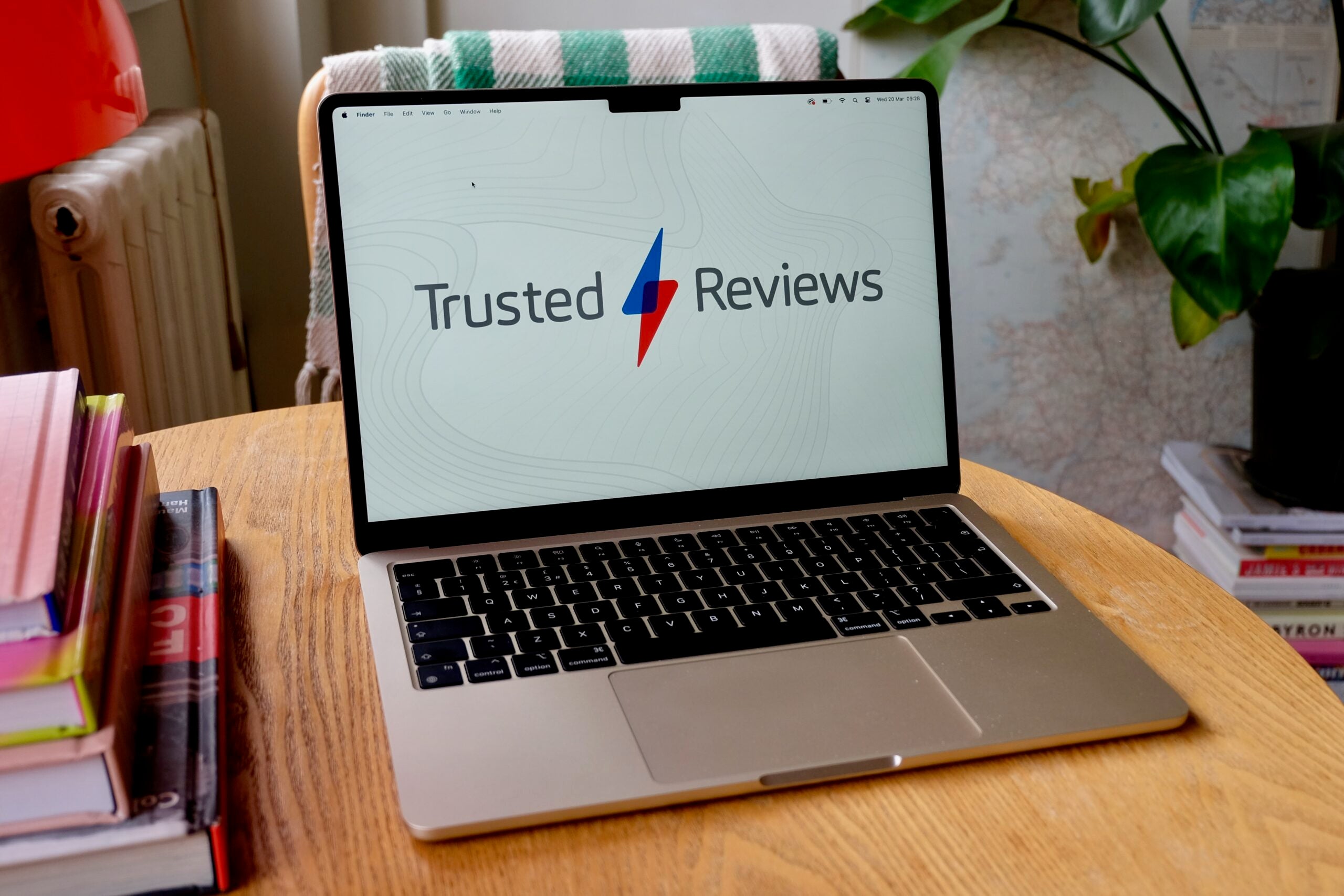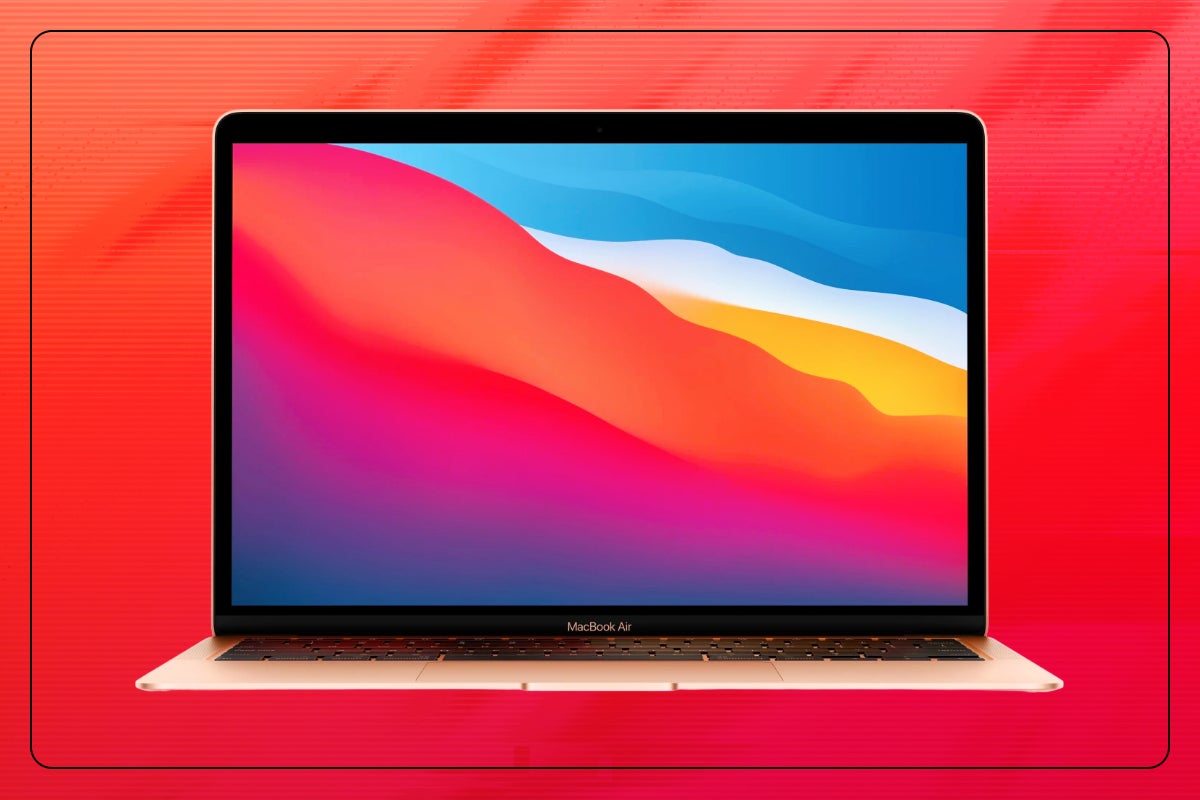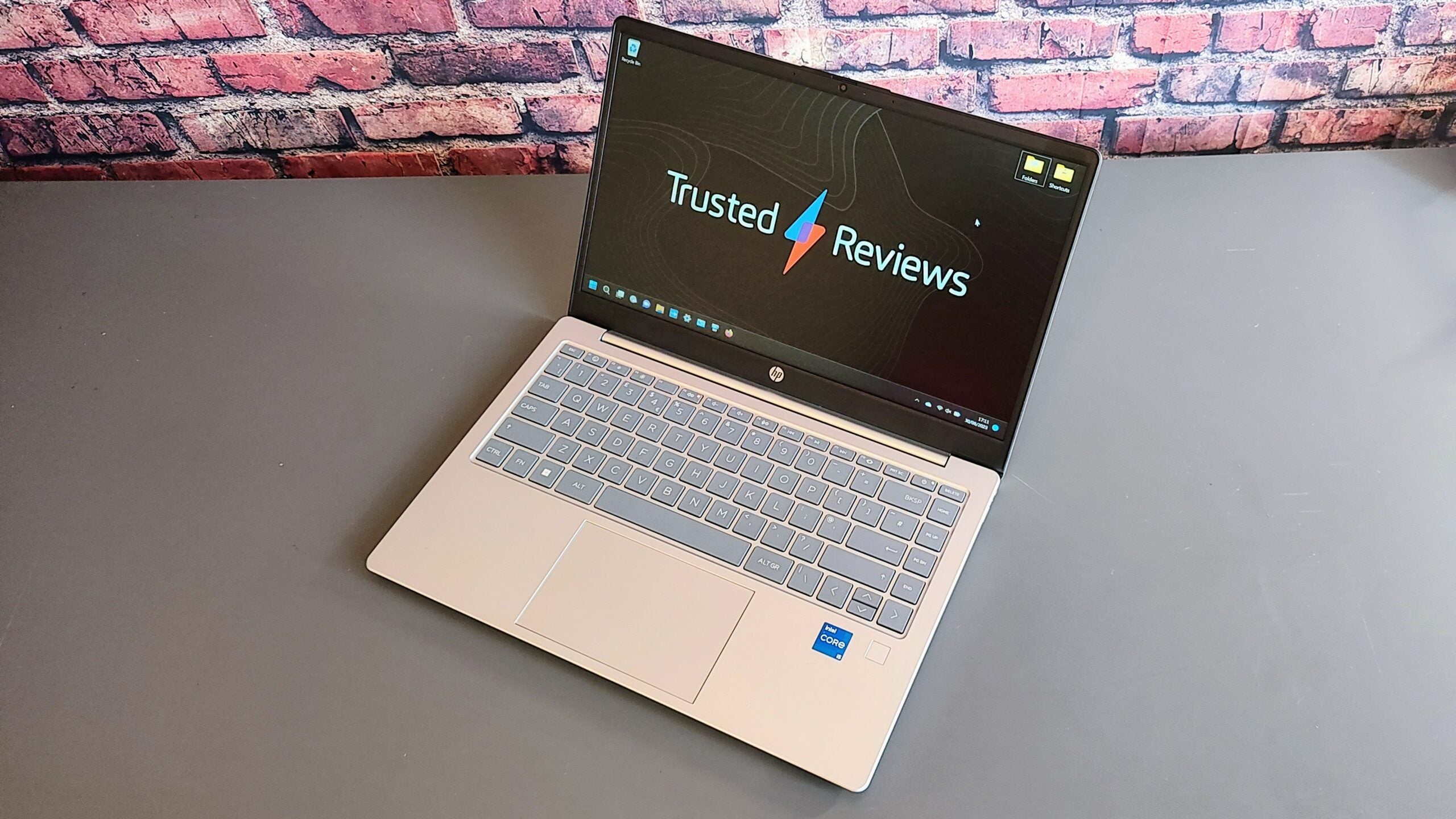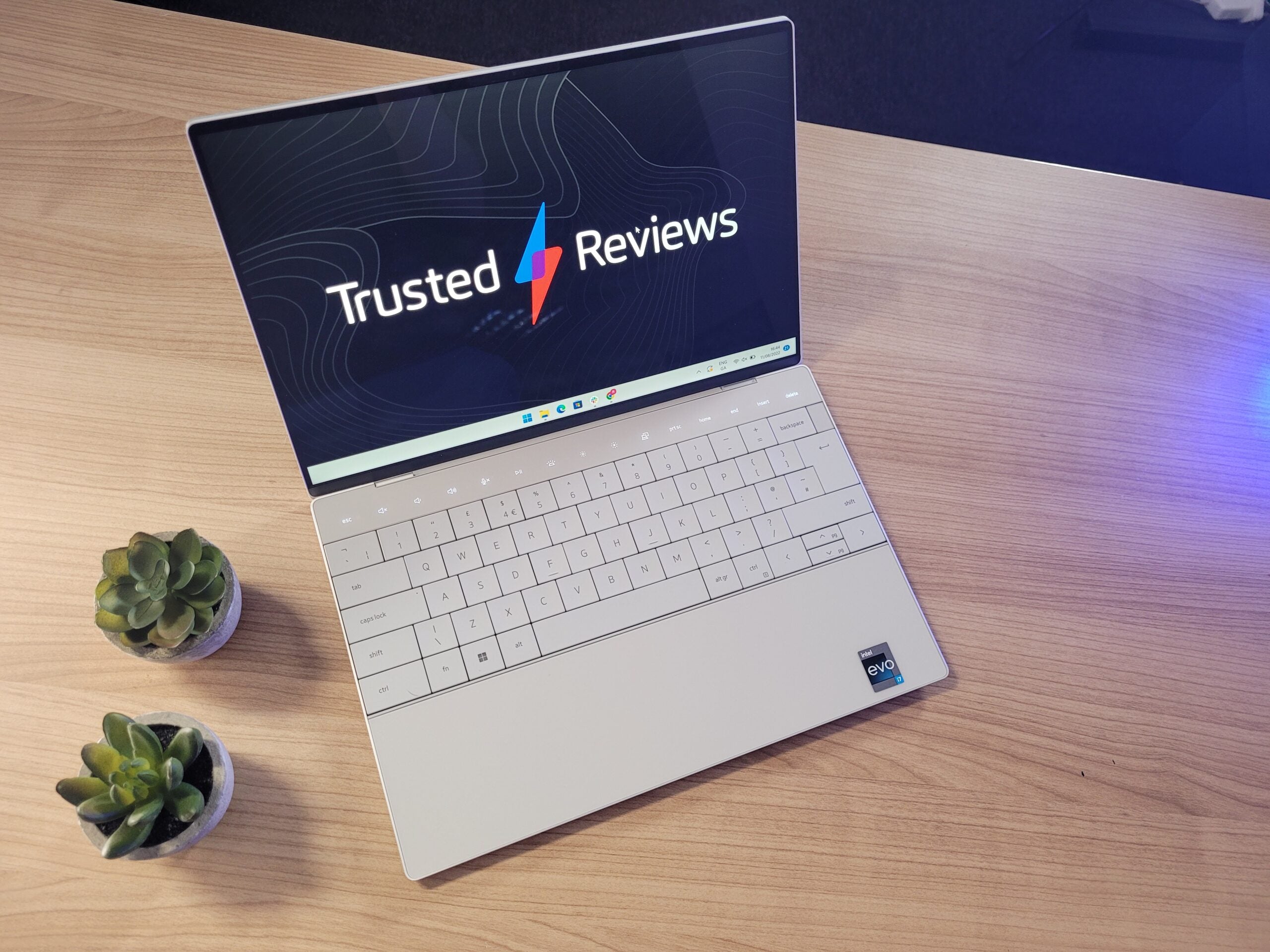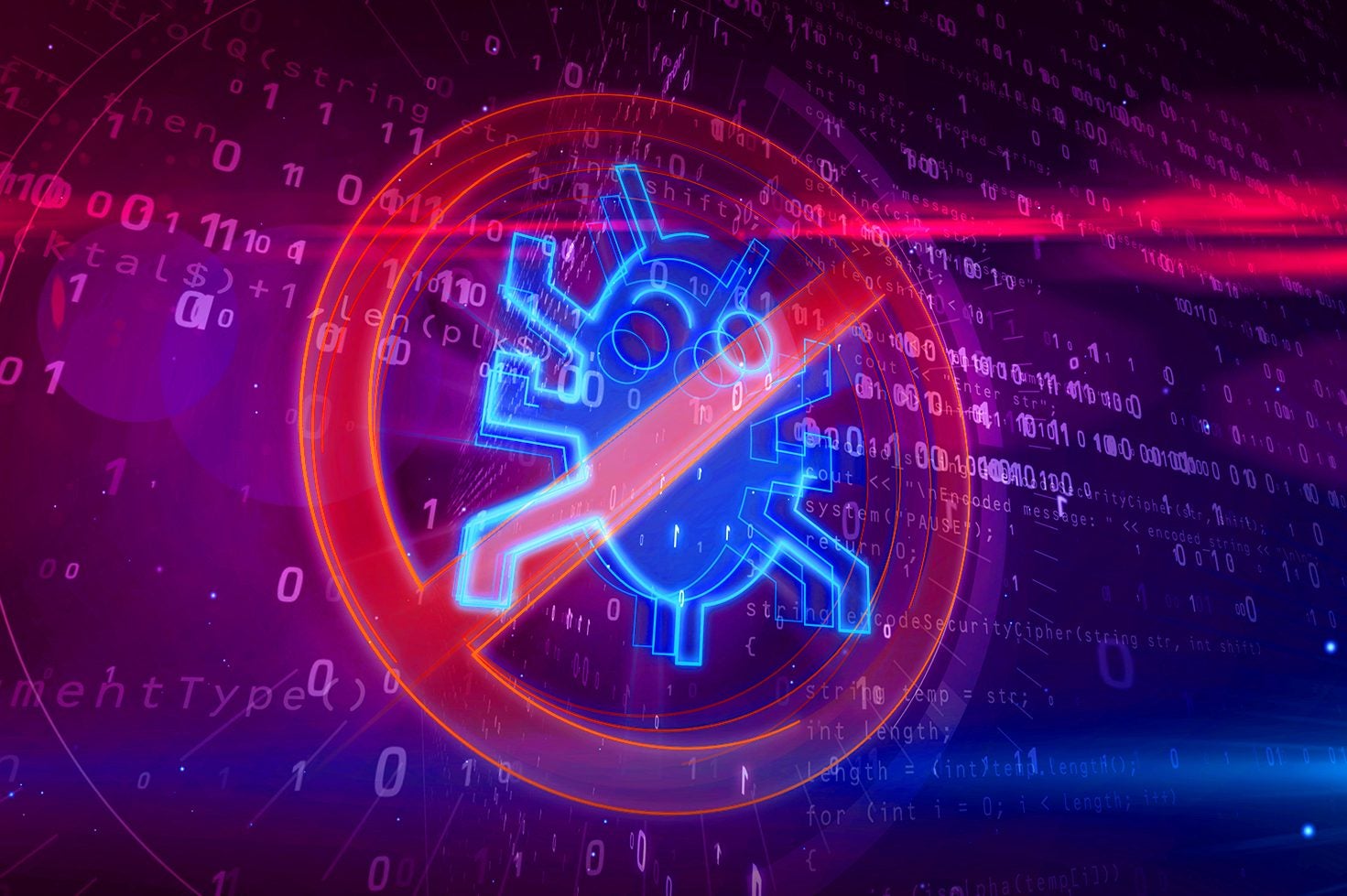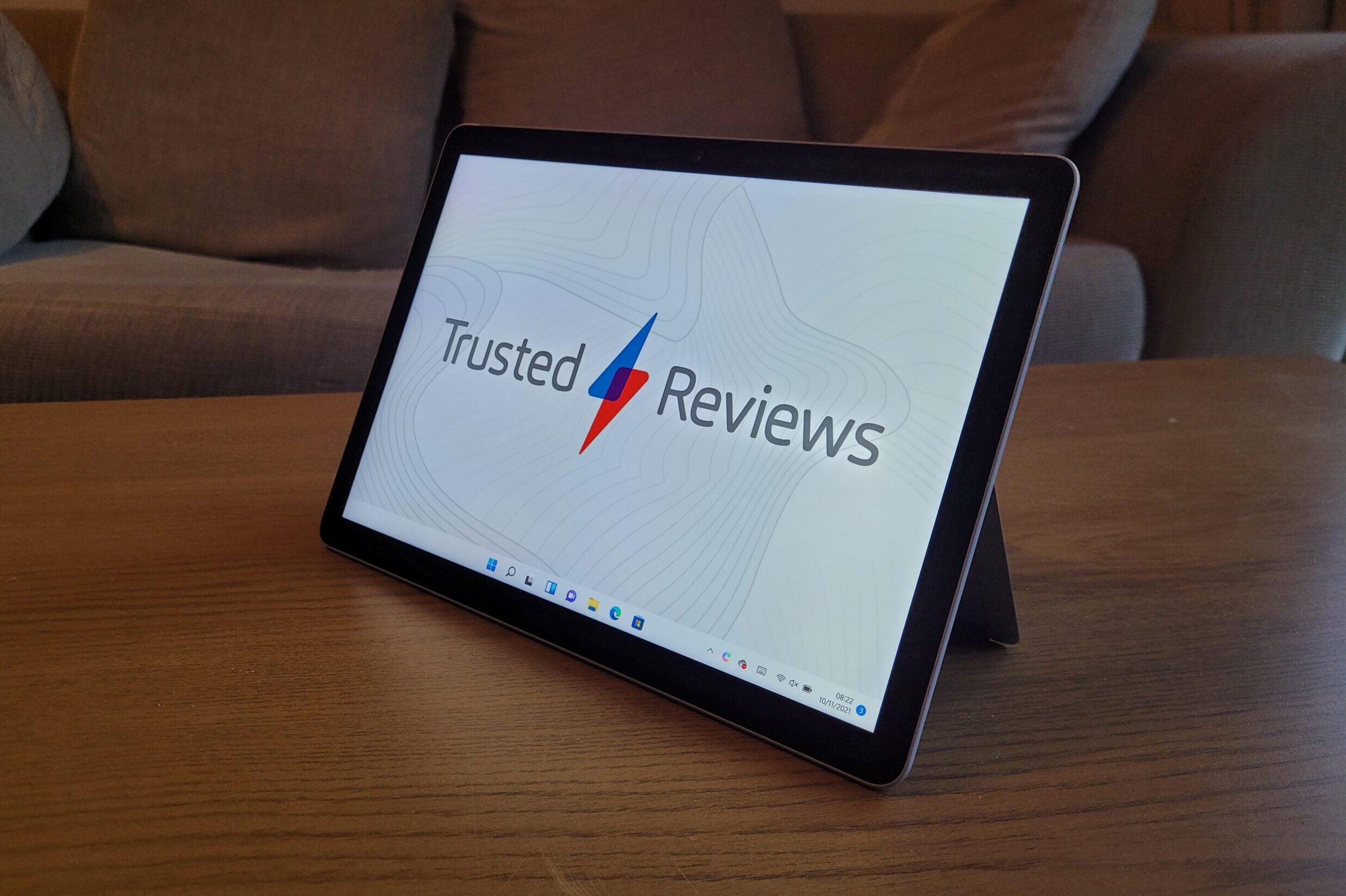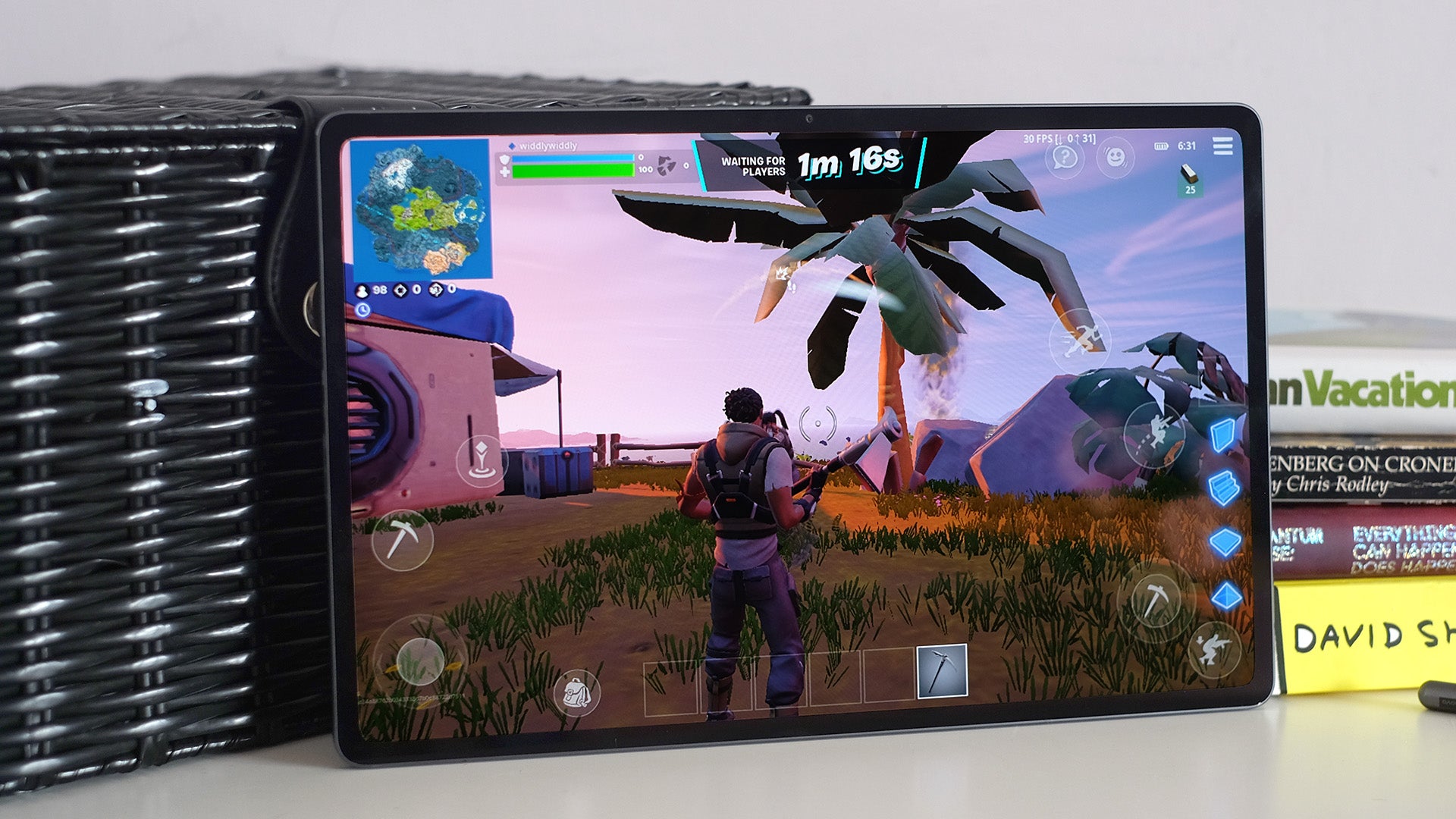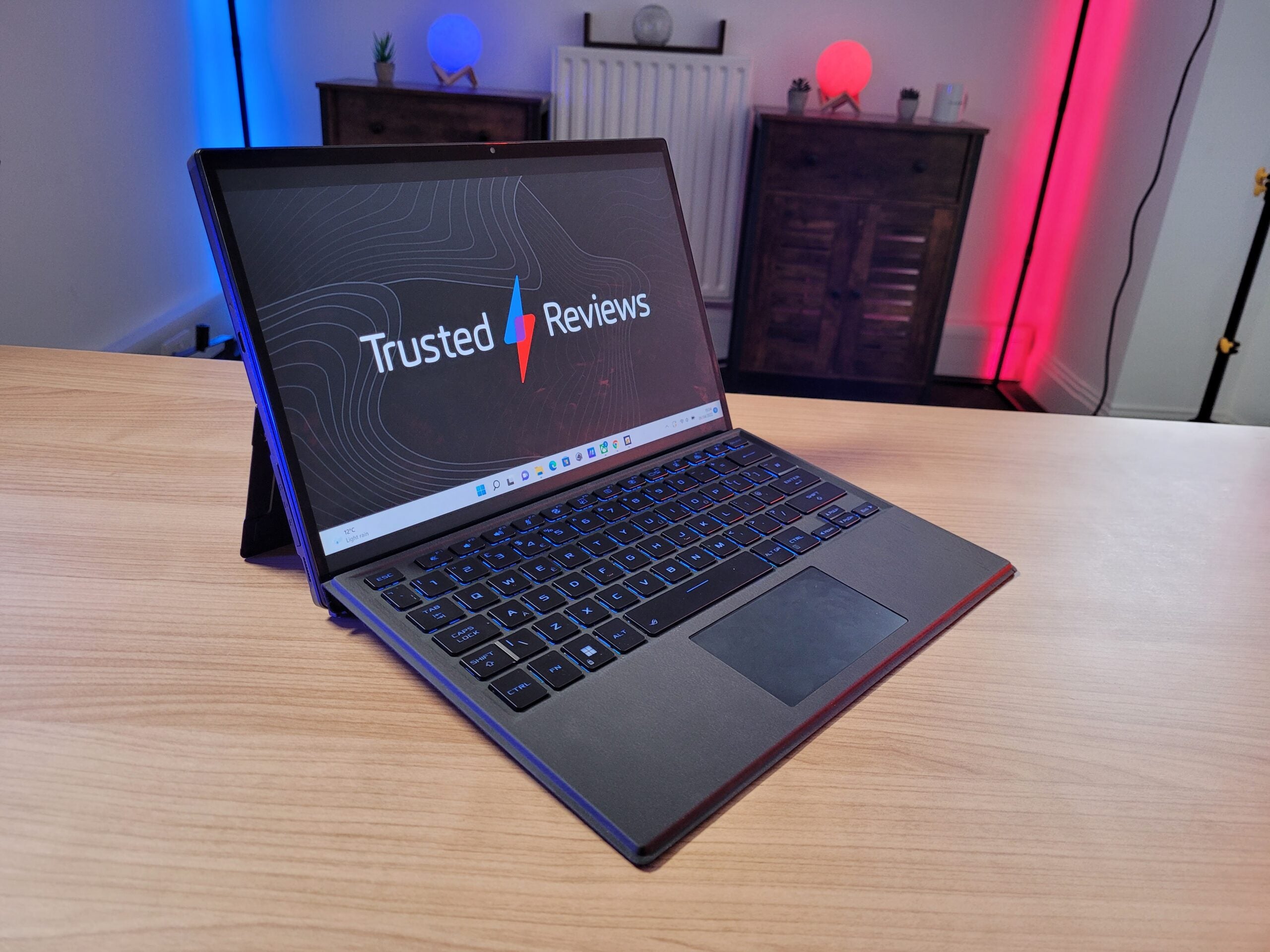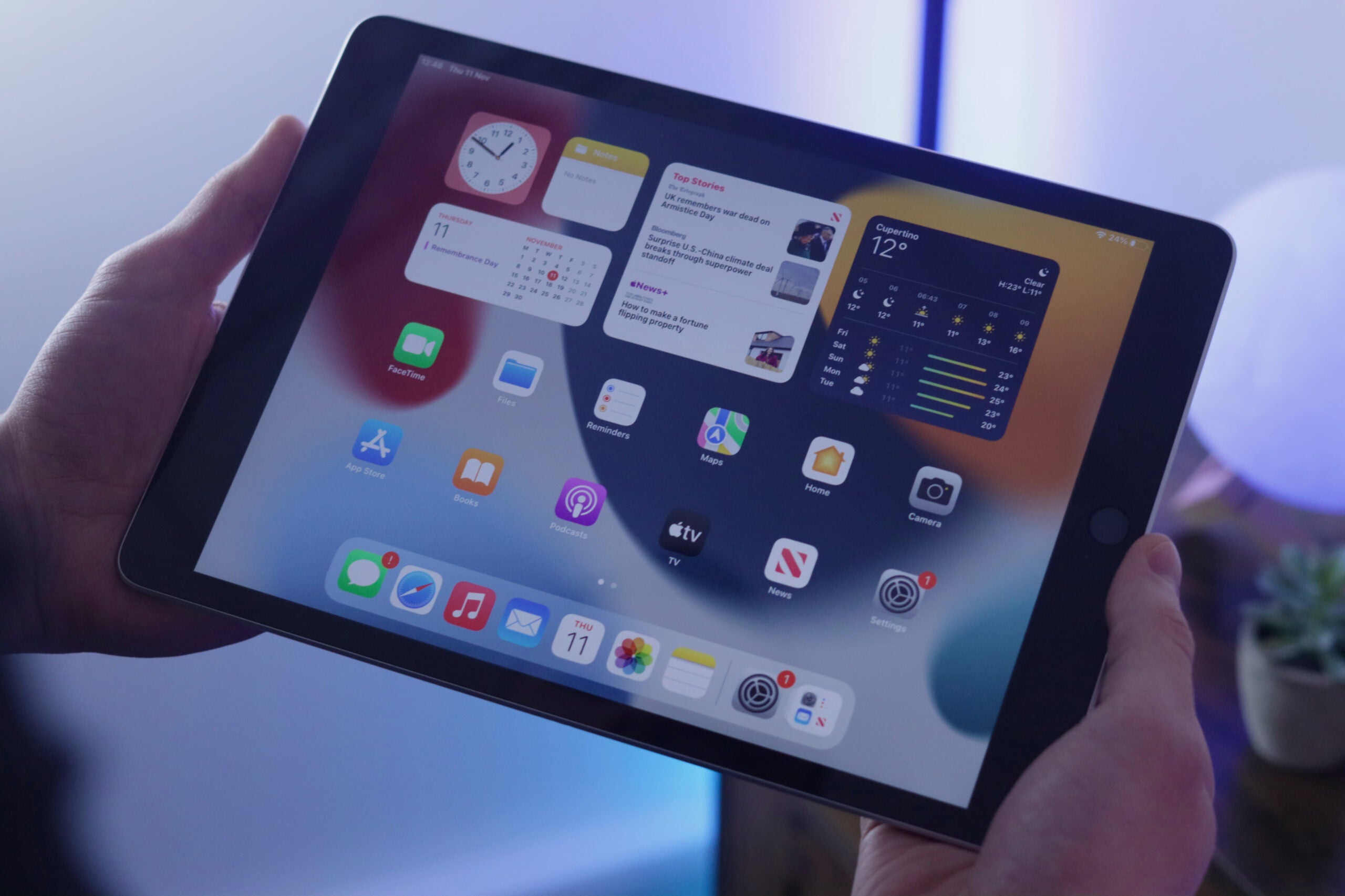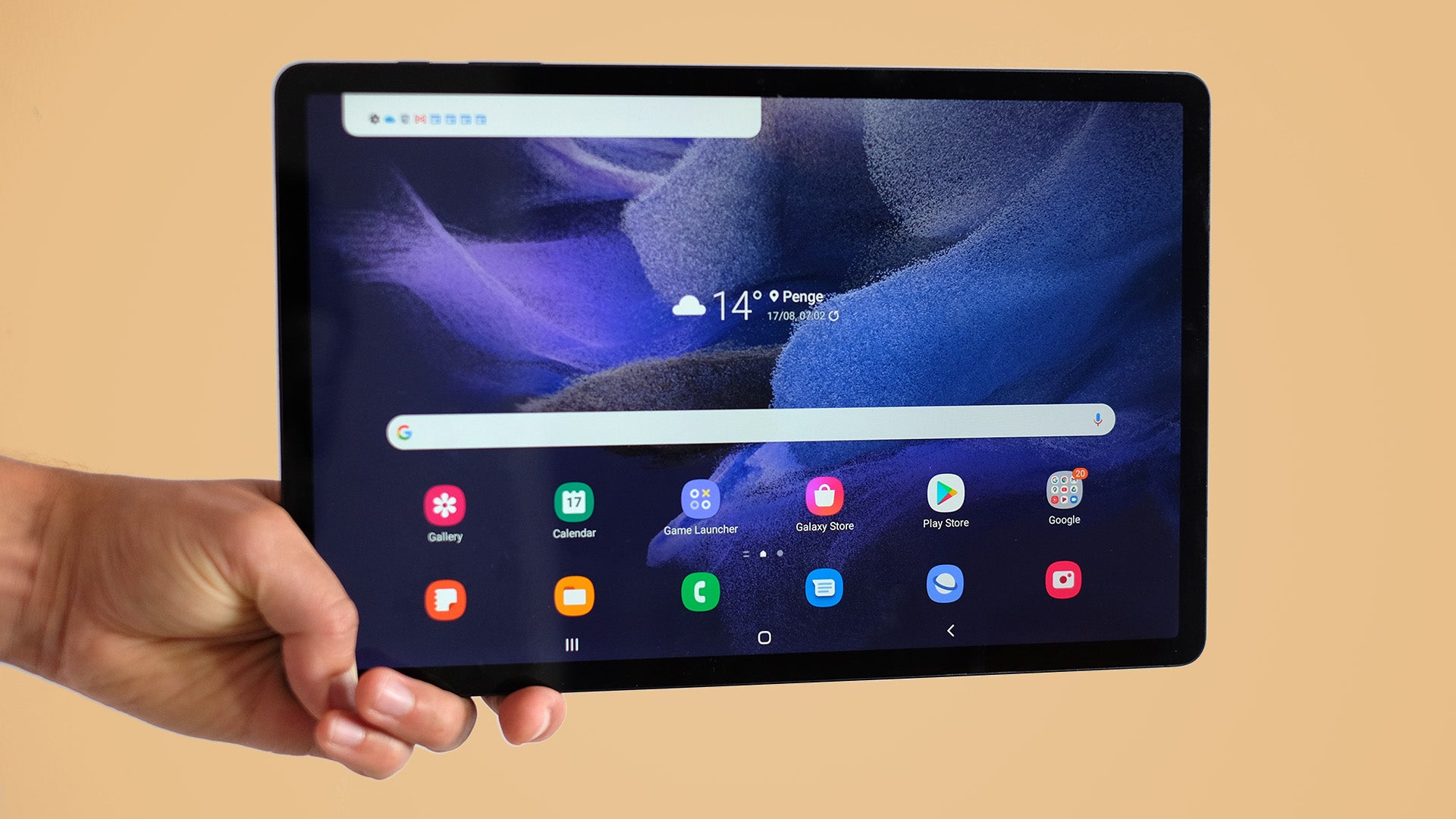Best Tablet 2024: The top tablets tested and rated
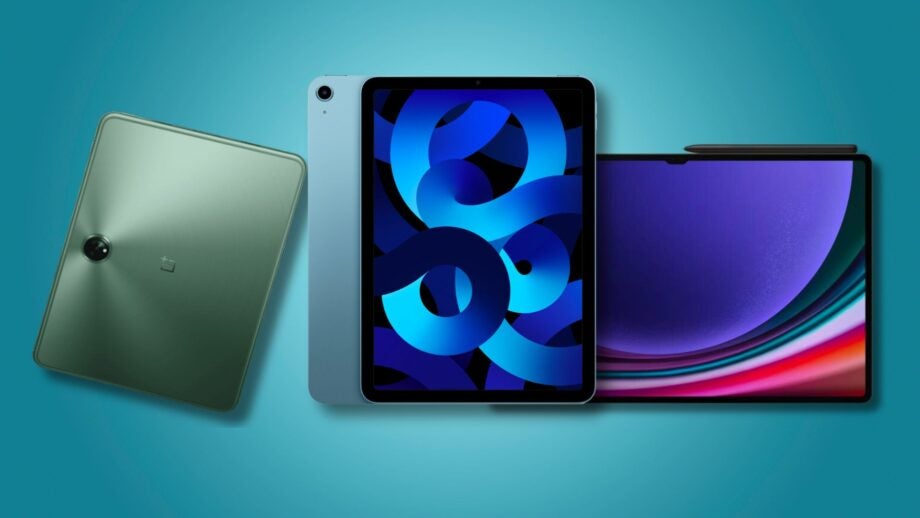
Once stuck in a no-man’s land between smartphones and laptops, tablets are now incredibly versatile devices and we’ve ranked the best of them to ensure that you get paired with the right one.
What’s most surprising about tablet computers in 2024 is that, in certain use cases, they can absolutely perform as your sole productivity device. For instance, writers can make use of apps like Google Docs and Scrivener while creatives have access to incredible editing apps like LumaFusion and Canva. Unless you’re looking to do some heavy duty 3D modelling, tablets have most tasks on lock.
There’s also a ton of choice out there to suit a wide range of budgets. For instance, if you have no limit on the amount you can spend then the iPad Pro M2 stands tall as a portable powerhouse, but for something more affordable there are plenty of solid Amazon Fire tablets to choose from. In fact, we have a separate rundown of the best Fire tablets that you can also peruse through.
Given their popularity and the fact that Apple has been developing its tablet range for many years now, it should come as no surprise that a handful of iPads appear on this list but if you use an Android phone and you want something that can pair well with your handset then we also have a ranking of the best Android tablets on the market.
Best tablet at a glance
- Best overall: iPad Air 5 – check price
- Best Android tablet: OnePlus Pad – check price
- Best for gaming: Samsung Galaxy Tab S9 Ultra – check price
- Best for creatives: iPad Pro M2 – check price
- Best for streaming: Lenovo Tab Extreme – check price
- Best small tablet: iPad mini 6 – check price
- Best Amazon Fire tablet: Amazon Fire Max 11 – check price
- Best entry-level iPad: iPad (10th-gen) – check price
- Best for home use: Google Pixel Tablet – check price
- Best value tablet: Honor Pad 9
How we test
Every tablet in this list has been properly tested and used for an extended period of time by one of our product experts. We categorically do not recommend a product unless it has been put through our lab tests and used by the reviewer as their main tablet for at least five days.
Lab testing includes colourimeter checks to gauge screen accuracy and max brightness levels, synthetic benchmarks to evaluate graphics and general performance, and battery drains to assess average discharge rates for basic office tasks, streaming video and gaming.
Our reviewer will then move on to consider the tablet’s performance for everyday use. This will see them use it as their primary tablet and enact common tasks such as movie streaming, gaming, web browsing and video calling. If the device is targeted at a specific market such as digital artists, they’ll also consider areas such as digital stylus support and whether it can effectively run relevant applications.
When a device is sent in for review with optional extras, such as a stylus and keyboard cover, we’ll assess its performance both as a standalone product as well as with any accompanying peripherals.
 Best overall
Best overall
- Great display
- Support for excellent accessories
- Seriously powerful internals
- Attractive design and array of colours
- Annoying front camera placement
- No 128GB storage option
- Creaky body
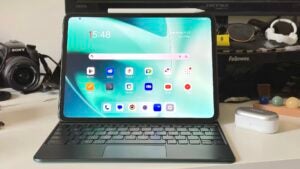 Best Android tablet
Best Android tablet
- Premium, svelte design
- Large 144Hz display
- 67W fast charging is rapid for a tablet
- No fingerprint reader
- Disappointing accessory software support
- Android tablets lack key pro tablet apps
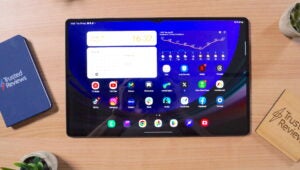 Best for gaming
Best for gaming
- Big display is ideal for movies and multitasking
- IP68 water resistance
- Access to previously iOS-exclusive apps
- S Pen is great for note-taking
- Not as portable as a regular tablet
- More expensive
- Very similar to its predecessor
 Best for creatives
Best for creatives
- Stunning display on the 12.9-inch version
- Fantastic design and finish
- Lots of tablet apps
- So much power
- Only the 12.9-inch model gets the best screen
- Very few upgrades over previous model
- M2 chip feels a little wasted
 Best for streaming
Best for streaming
- Plenty of processing power
- Stunning 14.5-inch OLED display
- 68W fast charging capabilities
- A little too expensive
- Android lacks some ‘pro’ apps available on iOS
- Not the most powerful processor available for the price
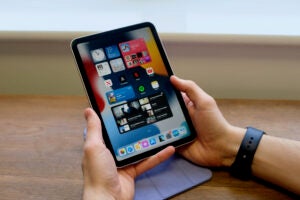 Best small tablet
Best small tablet
- Great new design
- Works with the second-gen Apple Pencil
- Super-speedy thanks to the A15 Bionic chipset
- 5G option makes for great portability
- Odd storage sizes
- Expensive
- Some iOS elements are too small
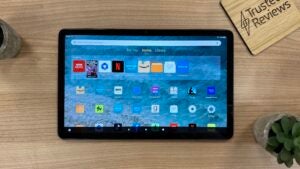 Best Amazon Fire tablet
Best Amazon Fire tablet
- Much more premium design than other Fire tablets
- Great all-day battery life
- Solid 11-inch 2K display
- Limited app availability
- Very slow to charge
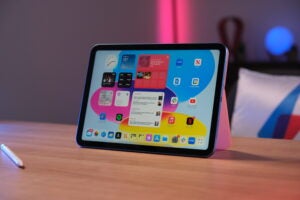 Best cheap iPad
Best cheap iPad
- The design is a massive upgrade
- USB-C is far more convenient than Lightning
- Smart front camera placement
- Unbeatable tablet apps and software
- Huge price jump, especially in Europe makes its position in Apple’s iPad range confusing
- Odd Apple Pencil integration
- 64GB isn’t enough (256GB probably too much)
 Best for home use
Best for home use
- Sharp screen
- Dock is a handy charging accessory and a unique feature
- Far more affordable in the US
- Pixel UI works well on a tablet
- Dull design
- The speaker dock doesn’t sound great
- Screen only 60Hz
- Price is far too high in the UK
- Doesn’t have all the Nest Hub software features
- Big 120Hz screen
- Supports all of Google apps and services
- Affordable but reasonably powerful
- Looks great
- No fingerprint sensor
- OLED would’ve been nice
- Cameras are bang average
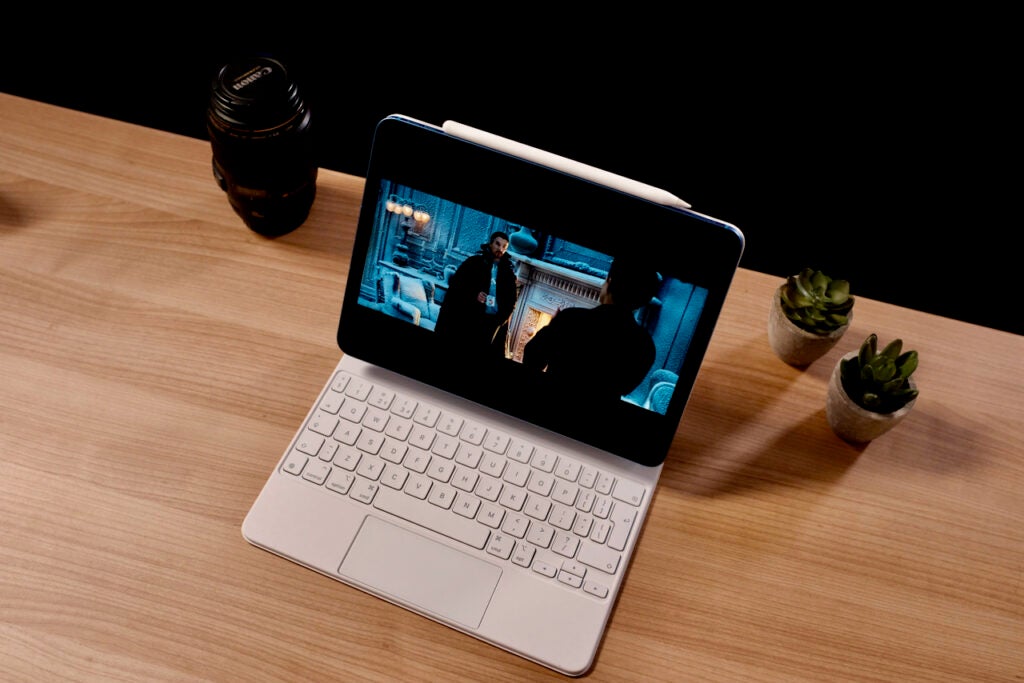
iPad Air 5
The best tablet for most people
Pros
- Great display
- Support for excellent accessories
- Seriously powerful internals
- Attractive design and array of colours
Cons
- Annoying front camera placement
- No 128GB storage option
- Creaky body
The iPad Air 2022 is the best all-round tablet we’ve reviewed and the option we’d recommend to most people.
Reviewing the device, we struggled to find any serious issues with the tablet. Straight out of the box, the tablet presented the premium, well-built feeling that has assured iPad Air tablets have been consistent high scorers at Trusted Reviews. The metal finish feels nice to the touch and suffers no flex when pressed; following a fortnight with the device, and an accidental drop, our review unit remained free of any damage free.
As a piece of hardware, it’s also excellent. In tests we found the iPad Air 2022 more than powerful enough for everyday use. Powered by Apple’s M1 chip, the same silicon seen in its MacBook Air M1 and the last gen Apple iPad Pro line, the tablet blasted through every process thrown its way. Every game we opened ran hassle-free, and the device never once heated up, even when tackling large-scale vector graphics work in Affinity Designer. Trust us when we say – despite being part of Apple’s Air, not Pro, line of tablets, this is a powerhouse performer.
Apple’s iPadOS software is also significantly more developed than that of Android. During testing, we never struggled to find an app for the process we wanted to run. This makes it wonderfully flexible and suitable for use as a backup when paired with the option Apple Pencil and Magic Keyboard.
The only minor issue is that, like all Apple peripherals, the keyboard and stylus are expensive additions. We also aren’t the biggest fans of the keyboard cover’s switches, which still feel a little squishy compared to most of the dedicated laptops we test. We’d only recommend it for taking notes during lectures, rather than for writing dissertations, as a result.
The 11-inch screen is great for watching video content, offering suitably bright and accurate colours for an immersive viewing experience. Our reviewer was also impressed with the tablet’s speakers, which offered surprisingly powerful and detailed audio, to make watching TV in bed a blast.
If that wasn’t enough, our tests showed that the iPad Air 4 is capable of offering users all-day battery life. Our reviewer regularly managed 10 hours of heavy use before the tablet required charging. Streaming 10 hours of a downloaded iTunes video, the battery still had 3% remaining during our tests.
Our only slight quibble is that, unlike many of its Microsoft and Google rivals, the screen is a basic LCD panel with a locked 60Hz refresh rate. This means the device fell slightly short of delivering the deep blacks seen from its Pro Mini-LED siblings and Android rivals such as the Galaxy Tab S8 Ultra, which has an OLED screen.
We’d also have liked Apple’s Promotion to make an appearance. Promotion is a screen technology that boosts the tablet’s refresh rate to 120Hz, enabling it to render twice as many images per second. The feature works great and, based on our experience, ensures the Pro screens feel much smoother to use than those of the Air models.
Ordinarily, we’d have forgiven the Air considering its price; but, recently, we’ve seen rival devices at the same price, such as the Xiaomi Pad 5 with its 120Hz screen, pass through our labs. As such, the Xiaomi Pad 5 is a great alternative for those looking for an all-round awesome 11-inch tablet, but who aren’t embedded in Apple’s software ecosystem.
Reviewer: Max Parker
Full review: iPad Air 2022 Review
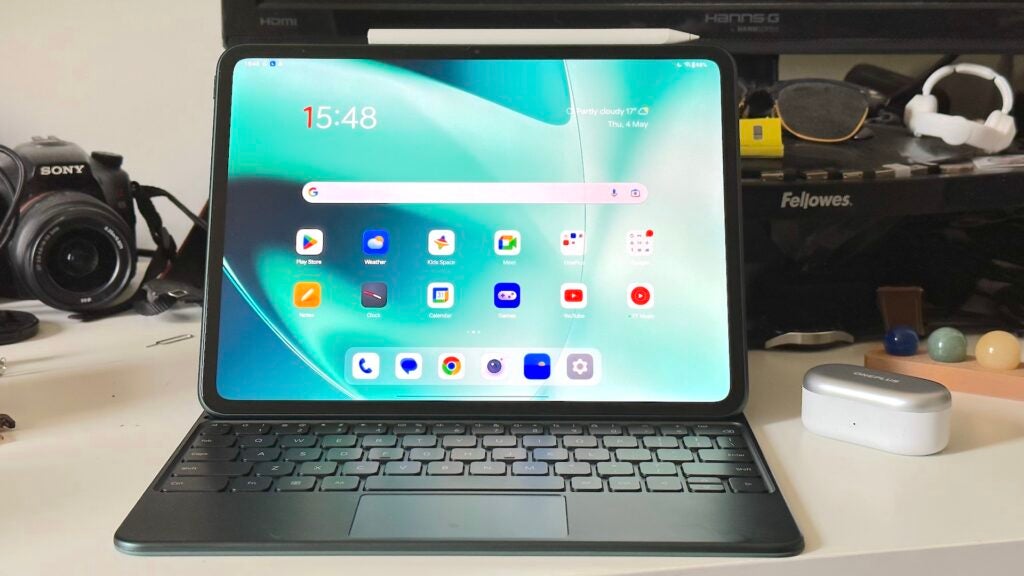
OnePlus Pad
The best Android tablet
Pros
- Premium, svelte design
- Large 144Hz display
- 67W fast charging is rapid for a tablet
Cons
- No fingerprint reader
- Disappointing accessory software support
- Android tablets lack key pro tablet apps
If you’re not a fan of Apple’s iPadOS operating system, the Android 13-based OnePlus Pad may be more up your street.
Based on our results, the device is a powerhouse product that goes toe-to-toe with – at times, even beats – the iPad Air at a technical level. It sports a CNC-milled aluminium body with a slight 2.5D curvature that sits comfortably in the hand, and it’s pretty svelte at just 6.5mm thick. Like the iPad Air, the frame offered no flex at all when pressed.
The screen is LCD, like the Air’s, but it has a 144Hz refresh rate – faster than practically any other tablet on the market at any price point. It’s also larger at 11.65 inches. This makes the OnePlus Pad the ideal Android tablet for gaming, and Dolby Vision HDR makes content from supported apps like Netflix really pop.
The aspect ratio is also unique at 7:5, making it a solid option for split-screen multitasking and even work purposes when combined with the optional Keyboard case and stylus. The keyboard case was a particular highlight with a satisfying typing experience, though software improvements are needed to truly make the accessories shine.
Battery life is another highlight for the tablet, easily able to last 11 hours before needing a top-up, and standby time was equally impressive. OnePlus claims it can last up to a month on standby, and while we couldn’t verify those claims, it was seemingly always ready to go.
Besides, with 67W SuperVOOC charging – some of the fastest on a tablet – the OnePlus Pad can go from flat to full in just over an hour. It’s just a shame that the charger isn’t included in the box.
Some minor issues that stopped us from fully recommending the OnePlus on the same level as the iPad Air relate to the device’s software and use of a slightly less powerful (but still capable) Dimensity 9000 chipset. As is the case with nearly all the Android tablets we test, many apps aren’t optimised to run on screens of this size, and the OS lacks some key pro-level apps available on iPad too.
Still, if you’re looking for a competitive Android-based tablet with great hardware and a tempting price, the OnePlus Pad should be your go-to.
Reviewer: Lewis Painter
Full review: OnePlus Pad review
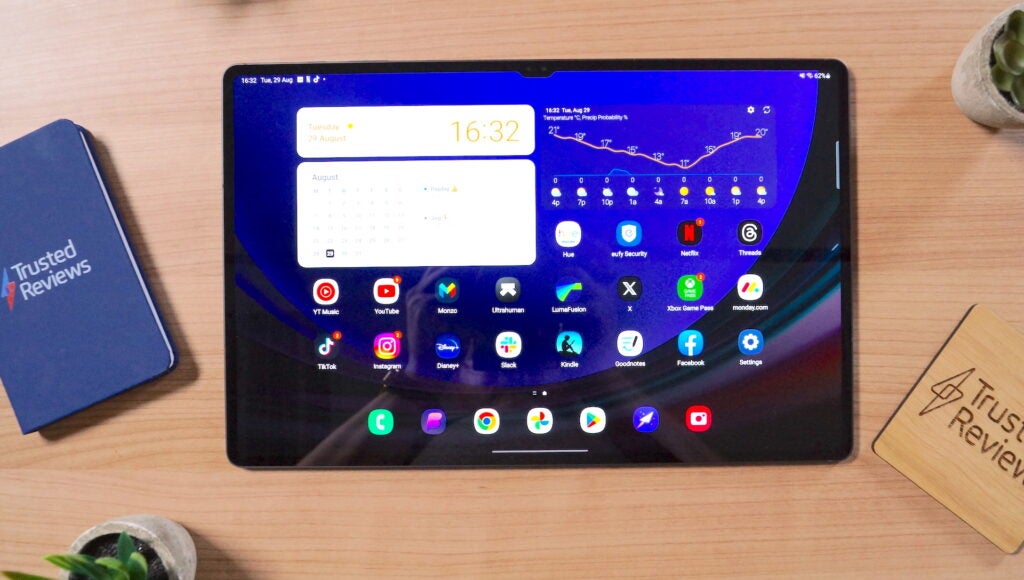
Samsung Galaxy Tab S9 Ultra
The best for gaming
Pros
- Big display is ideal for movies and multitasking
- IP68 water resistance
- Access to previously iOS-exclusive apps
- S Pen is great for note-taking
Cons
- Not as portable as a regular tablet
- More expensive
- Very similar to its predecessor
If you’re looking for a big-screen tablet with plenty of power to run some of the best games available on Android, the Samsung Galaxy Tab S9 Ultra is the ideal option.
The display is not only huge at 14.6 inches, but with Samsung’s Dynamic AMOLED 2X display technology, it’s smooth, rapid and responsive in everyday use with a buttery smooth 120Hz refresh rate ideal for gaming. The size means it’s not as portable as other options in our chart, taking up a similar footprint to a MacBook Pro 13 in a rucksack, but the large dimensions will no doubt provide the edge in competitive online titles like Call of Duty Mobile and PUBG.
What’s more, the Samsung Galaxy Tab S9 Ultra sports a unique top-end chipset that makes it more powerful than any other Android competitor – though still not quite up to the task of de-throning the M2 of Apple’s iPad Pro.
Still, the exclusive Snapdragon 8 Gen 2 for Galaxy chipset packs a higher CPU clock speed and an additional GPU core compared to the regular 8 Gen 2, the Tab S9 Ultra can handle just about anything you can throw at it. That not only means AAA games with high graphics enabled, but split-screen multitasking, video editing and anything else you could think of.
Even if you’re not an Android mobile gamer, the gorgeous display is well suited to both cloud gaming and binging series on Netflix.
Elsewhere, the S Pen provides a satisfying writing experience with a faster response time than the Apple Pencil 2, and it comes in the box too. There’s also IP68 dust and water resistance, a rarity among tablets, and solid battery life that can comfortably get you through a week’s sporadic use.
It’s just a little annoying that, at comfortably over £1000/$1000, there isn’t a charger in the box to take advantage of the tablet’s 45W fast charging. Even the iPad range still comes with a charger in the box.
Reviewer: Lewis Painter
Full review: Samsung Galaxy Tab S9 Ultra Review
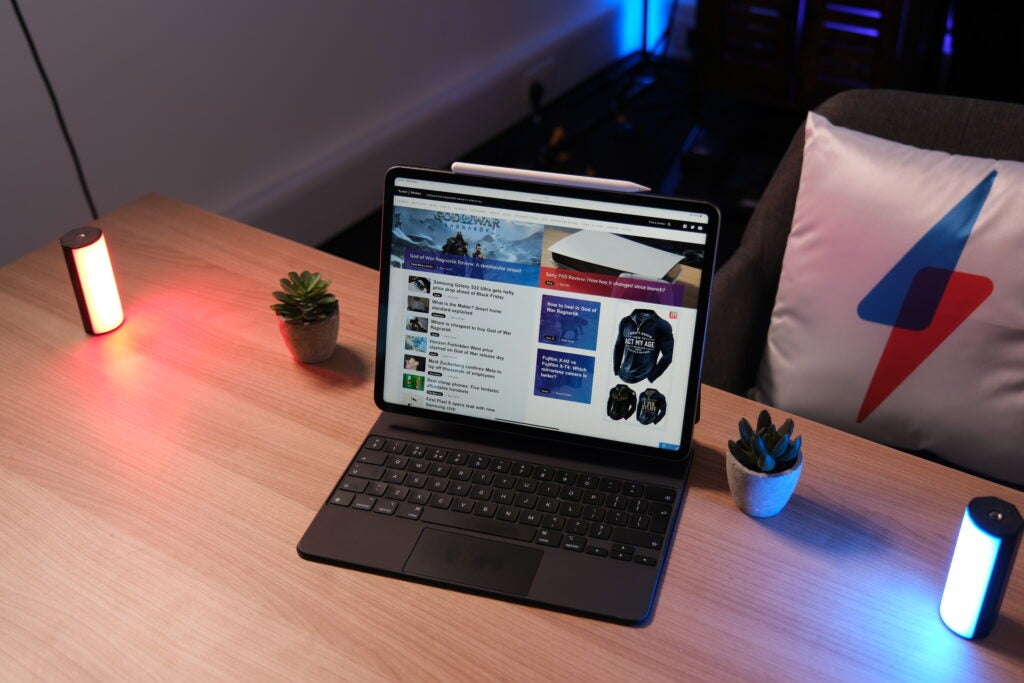
iPad Pro M2
The tablet for creatives
Pros
- Stunning display on the 12.9-inch version
- Fantastic design and finish
- Lots of tablet apps
- So much power
Cons
- Only the 12.9-inch model gets the best screen
- Very few upgrades over previous model
- M2 chip feels a little wasted
The iPad Pro M2 is the best tablet we’ve tested for those looking for pure high-end performance. If you’re a creative, an artist or someone looking to replace a laptop with a tablet then this is the best pick.
As the Pro branding suggests, this is the top-end Apple tablet and it boasts the most features. It’s also available in two sizes: 11-inch and 12.9-inch, with the larger model toting the very best screen we’ve ever seen on tablet.
In our tests, our reviewer was blown away by the display, with the Mini-LED 12.9-inch screen proving to be the best mobile panel for HDR content. We were wowed by the level of brightness on offer, and the accuracy of the colours displayed. The move to Mini-LED also made blacks look incrementally deeper than those rendered on the LCD iPad Pro M2 11-inch.
Cracking out our colorimeter, our naked-eye impressions were confirmed, with the iPad Pro delivering one of the best performances we’ve seen for a tablet marketed at creatives.
Our positive experience was further enhanced by the screen’s Promotion tech which is available on both sizes. This is Apple’s marketing term for high refresh rate and it means the iPad Pro M2 can display up to 120 images per second, up from 60 on the iPad Air. This makes everything feel a lot smoother, from drawing and sketching to gaming and scrolling Twitter.
The M2 chip powering the device is more than powerful enough to easily run every app tested, with our reviewer noticing zero performance issues, even when editing video. However, there are limited apps out there that will fully take advantage of this chip – at least at the time of review.
Reviewer: Max Parker
Full review: iPad Pro M2

Lenovo Tab Extreme
The best tablet for streaming
Pros
- Plenty of processing power
- Stunning 14.5-inch OLED display
- 68W fast charging capabilities
Cons
- A little too expensive
- Android lacks some ‘pro’ apps available on iOS
- Not the most powerful processor available for the price
If you’re hankering after a big-screen tablet, but don’t fancy the iPad Pro 12.9-inch, then the Lenovo Tab Extreme is a solid – and even bigger, if you can believe it – alternative.
The Lenovo Tab Extreme embodies the extreme moniker with its huge 14.5-inch display, but it’s not just big, sporting a 120Hz refresh rate, a 3.5K resolution and OLED tech for vivid colours and deep, inky blacks that make streaming HDR content on Netflix an absolute dream. Paired with the sheer size, it’s a decent replacement for a TV when away from home and also proved a particularly well-suited option for cloud gaming.
Embedded around that huge display is an all-metal body that measures in at an exquisite 5.9mm thick, helping offset just how unwieldy the large tablet can be to move around. Still, it looks and feels just as premium as the iPad Pro does.
Trying to match the iPad Pro’s capabilities, the Tab Extreme is compatible with the Lenovo Precision Pen 3 and a new keyboard case, and the company sells a bundle with both included for £999/$949. The stylus is ideal for creatives with 4,000 points of pressure and minimal lag, while the magnetic keyboard case is perfect for getting some work done.
Battery life is also solid despite powering such a large display with a whopping 12,500mAh cell that’s comfortably larger than most external battery chargers. As such, the Tab Extreme had no problem lasting an entire workday with constant use, and with 68W charging, it charged from flat to full in just under 90 minutes.
When it comes to performance, the tablet is powered by MediaTek’s Dimensity 9000 chipset, paired with 12GB of RAM and 256GB of storage. For reference, that’s the same chipset as the OnePlus Pad that costs half the price, but that’s more a testament to OnePlus’ value for money than the Tab Extreme being underpowered for the price.
Everyday performance is solid with no stuttering or lag, though our reviewer noted that the display’s 3.5K resolution was just too much to power high-end games. Performance is also behind what you’ll find from Qualcomm’s top-end Snapdragon 8 Gen 2 and Apple’s M2 processor, so those that need the most performance should look elsewhere, but for sheer streaming and cloud gaming capabilities, the Lenovo Tab Extreme is a particularly strong (if not pricey) option.
Reviewer: Sean Cameron
Full review: Lenovo Tab Extreme Review
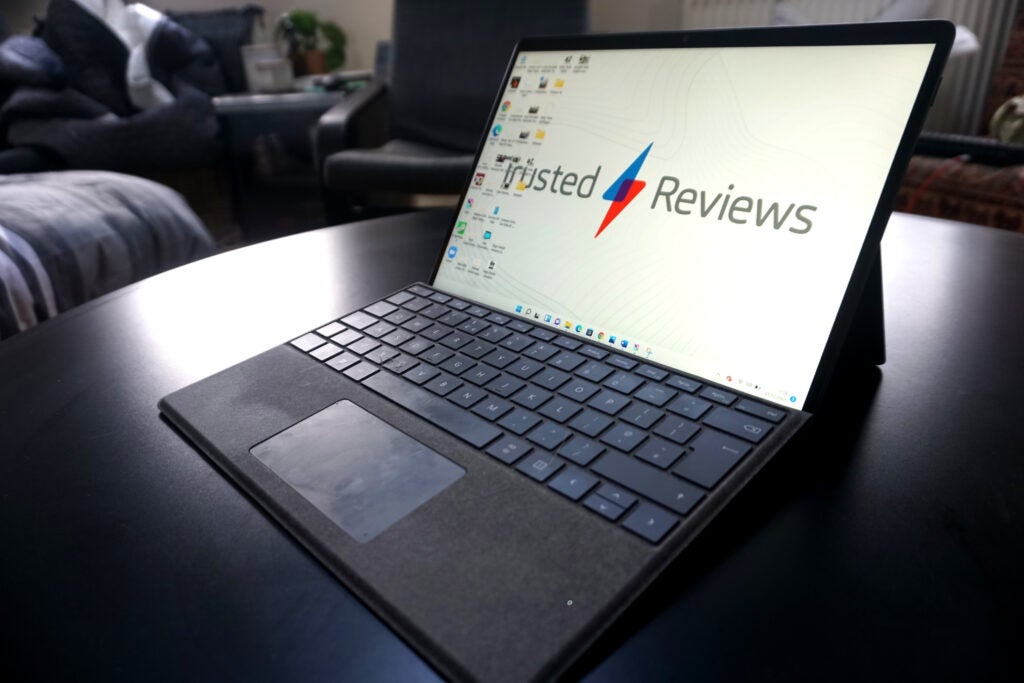
Microsoft Surface Pro 8
The best tablet for work
Pros
- Solid performance
- Great screen for work and play
- Reliable battery life, especially in 60Hz
- Well-built kick stand
Cons
- Signature Cover and Slim Pen 2 not included
- Limited port selection
If you want a tablet-come-laptop for work then based on our testing, the Surface Pro 8 is the tablet to buy. This is largely due to the tablet’s use of full-fat Windows 11. Our tests revealed that this made it the most versatile option as a working laptop replacement.
The tablet uses proper laptop processors and has access to every app and programme available on Windows. As such, our reviewer found that it was the only device on the list that could comfortably be used both as a 100% functional laptop for work and tablet for entertainment.
With every other device, including the iPad models, we experienced times where we had to move to a laptop to complete some work tasks. This usually occurred when we needed to plug peripherals such as colorimeter or older external monitors into the device, because iPadOS and Android had failed to recognise them.
Paired with a Type Cover, we also found the keyboard is one of the best available to a tablet. The new keyboard has a carbon fibre layer, which makes it feel a lot sturdier to type on, removing the flex I experienced with past Type Covers. The key’s switches also have a more pleasing and tactile actuation point than Apple’s Magic Keyboards, making it more comfortable to work on for prolonged periods.
From a hardware perspective, the Surface Pro 8 performed admirably. The 13-inch tablet uses an LCD panel, which means it wasn’t quite as nice as the Galaxy Tab S8 Ultra and iPad Pro 12.9-inch to watch Netflix on, which offer deeper blacks and generally more immersive viewing head-to-head. Nevertheless, screen quality is more than good enough for casual viewing on the go. I had no serious issues watching videos on a long train ride to Scotland.
The lack of a eGPU, like the 3050 Ti seen on the Asus ROG Flow Z13, meant we couldn’t get triple-A games to run locally at playable frame rates without radically downgrading the graphics. But the 120Hz refresh rate meant streaming games via GeForce Now felt suitably reactive with an Xbox controller connected.
During our review process we found battery life varied greatly, depending on what you were doing with the device. For office tasks such as word processing, video calling and managing Excel sheets, you’ll comfortably get a full workday’s use out of the Surface Pro 8, based on our experience with the device. But more intensive tasks, such as 3D modelling in Blender put a much bigger strain on the battery, with it lasting only around 3-4 hours. This is a lot less than the iPad Pro 12.9-inch.
Reviewer: Alastair Stevenson
Full review: Surface Pro 8 Review
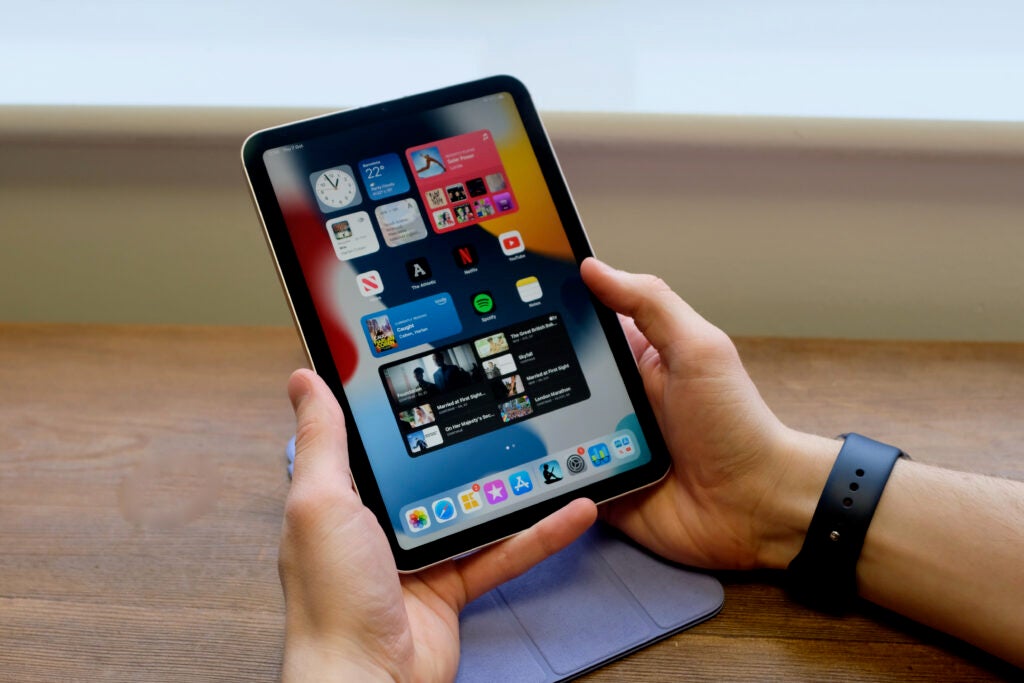
iPad Mini 6
The best small tablet
Pros
- Great new design
- Works with the second-gen Apple Pencil
- Super-speedy thanks to the A15 Bionic chipset
- 5G option makes for great portability
Cons
- Odd storage sizes
- Expensive
- Some iOS elements are too small
If you want a tablet that can easily fit into even the smallest of bags, then the iPad Mini 6 is the device for you.
We haven’t always been the biggest fans of Apple’s Mini iPads, with them tending to be the slowest to get upgraded in any significant way. The iPad Mini 5 offered a good but dull design that focussed on performance improvements and little more.
Which is the reason we were so surprised by the iPad Mini 6 when it entered our labs for testing. It was immediately apparent on taking the device out of the box that Apple had put much thought and care into upgrading the Mini for today’s market. The device sports a completely new, more modern design, and a number of small but important upgrades make it the best small tablet to pass through our labs in the last half-decade.
Design-wise, it looks like a shrunk-down version of Apple’s current-generation Pro and Air tablets. It’s been upgraded to feature Apple Pencil 2 support, too. The latter is particularly welcome, since it means the Pencil can be magnetically docked and charged on the tablet. The docking mechanism is much more elegant than that featured on the older model – which forced you to charge the Pencil using the tablet’s Lightning port – and made it far easier for us to keep tabs on the stylus through testing.
The A15 Bionic chipset isn’t as fast as the M1 that features in Apple’s more expensive iPads, but based on our benchmarks and experience using the Mini 6 as our daily tablet, it’s still more than powerful enough. In our time with the tablet, we never noticed any slowdown, with apps universally launching in milliseconds and running with zero performance issues.
The only downside is that while the size is great for people who want a portable tablet, the Mini isn’t quite as good for video streaming or gaming in a home environment as its larger Air sibling.
We found the 8.2-inch screen isn’t anywhere near as immersive for video viewing as the iPad Air, let alone the Pro or Galaxy Tab S8 Ultra. As well as its small size, placing it next to the iPad Air, which also has an LCD screen, blacks weren’t quite as deep. Thankfully, its high max brightness meant it proved suitably dynamic for casual video in bed or while travelling.
The lack of Apple’s Promotion tech means it’s locked at a bog-standard 60Hz refresh rate. This coupled with its small size meant that although it’s fine for mobile gaming on the go, the device is ill-suited for more serious players looking for a tablet from which to stream triple-A games. We found the HUD and text on PC games running via GeForce Now were a little too small to comfortably read when the tablet was sitting on a desk.
For such users, the iPad Air or Xiaomi Pad 5 with their larger screens are far better options.
Reviewer: Max Parker
Full review: Apple iPad Mini 6 review
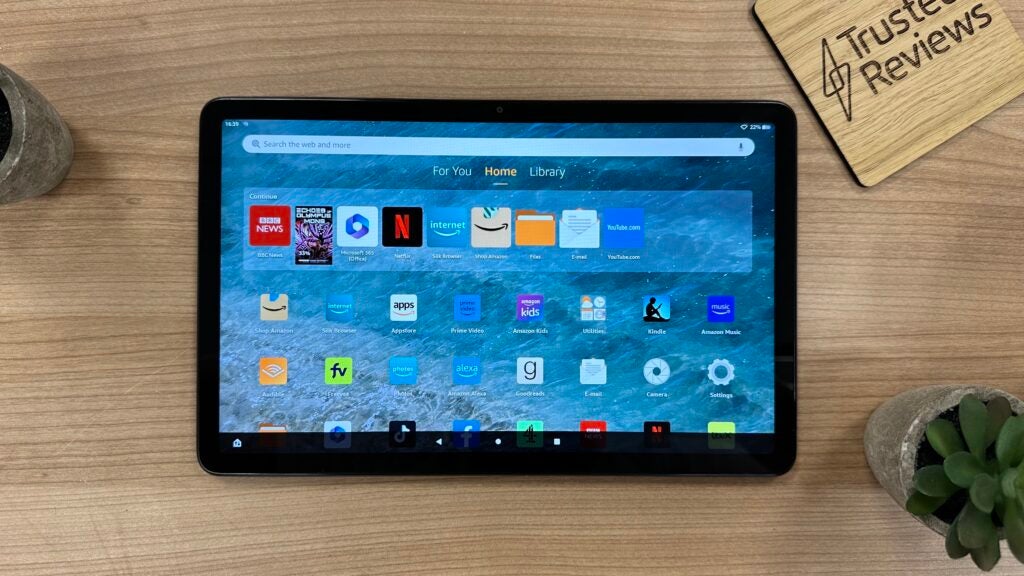
Amazon Fire Max 11
The best Amazon Fire tablet
Pros
- Much more premium design than other Fire tablets
- Great all-day battery life
- Solid 11-inch 2K display
Cons
- Limited app availability
- Very slow to charge
Amazon has its niche at the market’s budget end with a swathe of its own Amazon Fire-branded tablets coming in all shapes and sizes, from the small Amazon Fire 7 (2022) to the kid-proof Amazon Fire HD 10 Kids (2021). However, it’s the newest in the Fire tablet collection that truly stands out, even compared to fully-fledged Android tablets.
The Amazon Fire Max 11 stands at the top of the Fire tablet collection, not only in price at £249/$229 but size, sporting an 11-inch display. The display is one of the main reasons to opt for the tablet, boasting a 2K resolution that delivers pin-sharp visuals when watching movies, reading books on the Kindle app and browsing the web. It’s also fully laminated with no gap between the protective glass and LCD panel to create that horrid hollow tap sensation present on most cheaper tablets (and even Apple’s iPad 10).
It feels like a more premium device than others in the collection, with an aluminium body, rounded corners and relatively slim bezels. In fact, it looks a lot like the iPad 10, just much cheaper. It’s a shame that it’s only available in slate grey – more colourful options could help Amazon’s tablet stand out in a sea of grey tablets.
Performance is also surprisingly impressive considering it sports an unnamed octa-core processor and just 4GB of RAM, performing much better in CPU and GPU tests than most of the similarly priced competition, and everyday performance was refreshingly free of stutter and lag.
The Amazon Fire Max 11 is compatible with an optional keyboard case and stylus, with the stylus magnetically attaching to the side of the tablet when not in use. Amazon hopes this will frame the tablet as a work device, but it’s not entirely up to the same standard as most competitors – and that’s down to Fire OS.
Despite running on Android 11, the Fire Max 11 (like all other Fire tablets) is devoid of Google services and Google Play, instead offering its own alternative in the form of the Appstore. While plenty of apps are available, including Microsoft Office, it lacks key apps like Google Drive or Dropbox that’d make it handy for work purposes.
You will find most streaming apps, however, and plenty of free-to-play games, framing the tablet as more of a high-end (for Fire tablets, anyway) entertainment device than a work one.
Reviewer: Lewis Painter
Full review: Amazon Fire Max 11 Review

Apple iPad 10th gen
Best cheap iPad
Pros
- The design is a massive upgrade
- USB-C is far more convenient than Lightning
- Smart front camera placement
- Unbeatable tablet apps and software
Cons
- Huge price jump, especially in Europe makes its position in Apple’s iPad range confusing
- Odd Apple Pencil integration
- 64GB isn’t enough (256GB probably too much)
Bringing in a complete redesign for Apple’s entry-level tablet that makes it look far more like the iPad Air range, there’s a lot to like about the iPad 10. In addition to its new look and much like the iPhone 15, it’s done away with Apple’s Lightning port of old in favour of USB-C.
At present, the iPad 10 is also the only model in the entire iPad range that features a landscape placement for its front-facing camera, meaning that it works far more like a laptop or webcam when it comes to Zoom calls. No more video from a slightly off-centre angle.
Just like its predecessor, the iPad 10 has a strong battery life and you can readily anticipate getting through 10-hours of video playback, which is more than enough for plodding on through a day’s work. Unfortunately, there is a hefty price bump to contend with and the screen offers no laminated protection against sun glare so it’s not the best option to use in the great outdoors. Given that the iPad 9 is still for sale, the iPad 10 works far better as a productivity device than an entry-level tablet for entertainment.
Reviewer: Max Parker
Full review: Apple iPad (10th Gen) review
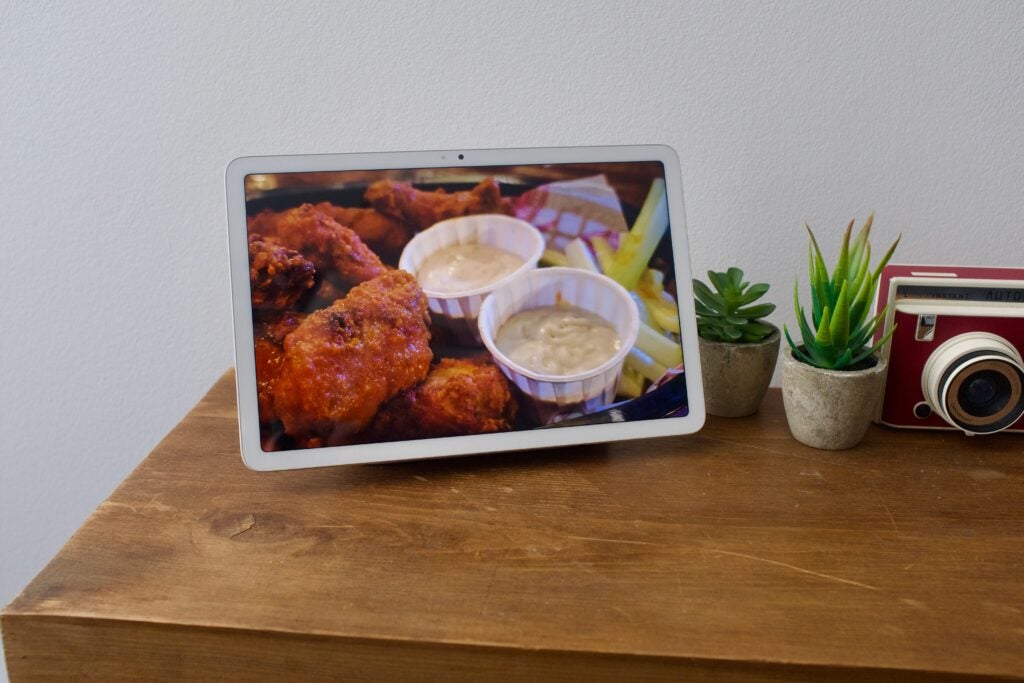
Google Pixel Tablet
Best home tablet
Pros
- Sharp screen
- Dock is a handy charging accessory and a unique feature
- Far more affordable in the US
- Pixel UI works well on a tablet
Cons
- Dull design
- The speaker dock doesn’t sound great
- Screen only 60Hz
- Price is far too high in the UK
- Doesn’t have all the Nest Hub software features
In our Best Lists, we tend to only include products which score 4 out of 5 – picking up a Recommended badge in the progress. However, Google’s first Android Pixel tablet is still deserving of a spot because for the right type of buyer it is a great device.
What really sets this apart from all the other tablets on this list – including the iPads and other Android tablets – is the wireless docking station included in the box. Dock the Pixel Tablet onto this and it turns from a standard 11-inch device into a home hub, capable of playing music, showcasing snaps from Google Photos or just the time. It makes the tablet a device that can be used all the time, rather than sparingly for checking emails or browsing the web.
We would like the speaker to sound better, and Google Assistant isn’t always reliable for voice commands however it’s nice to see a tablet try something different.
Elsewhere, it’s all fairly standard stuff. The screen is sharp, yet the 60Hz refresh rate can’t match the OnePlus Pad and it feels like a little slow as a result. There are no official keyboard or stylus accessories either, so this isn’t a great choice for those who want a laptop replacement.
Reviewer: Max Parker
Full review: Google Pixel Tablet review

Honor Pad 9
Best value tablet
Pros
- Big 120Hz screen
- Supports all of Google apps and services
- Affordable but reasonably powerful
- Looks great
Cons
- No fingerprint sensor
- OLED would’ve been nice
- Cameras are bang average
The Honor Pad 9 is an excellent value tablet, offering solid performance and a lovely display at an affordable £299.99 price. It’s also a better deal than the 10th-generation iPad for many people.
The Honor Pad 9 has a slender, lightweight build at just 555g despite a large display. The 12.1-inch screen is surrounded by uniform bezels and the 8-megapixel front camera sits on the horizontal edge, ideal for joining video calls. All of the buttons are neatly located on the sides of the tablet and Honor has opted for facial recognition or a passcode over a fingerprint sensor.
The 2.5K IPS display gets impressively bright and looks great despite not being an OLED screen. It also has a slick 120Hz refresh rate and a decent set of speakers, though the bass is lacking.
Turn the tablet over and you’ll find a single 13-megapixel camera that’ll work in a pinch, but probably won’t come close to your smartphone camera. We found that the camera struggled to handle light, with daytime snaps often appearing washed out and indoor scenes overly dark. Video-wise, the rear camera supports 4K shooting at 30fps, or 1080p video at 60fps.
Performance-wise, the Honor Pad 9 is powered by Qualcomm’s Snapdragon 6 Gen 1. Performance falls behind rival tablets like the iPad 10th gen and the OnePlus Pad, the price difference makes the Honor Pad 9 a great deal regardless. The tablet has no issue handling multitasking, videos and games, from Marvel Snap to League of Legends: Wild Rift.
The tablet runs Android 13 with Honor’s own overlay and supports all of the expected Google services, including the Play Store, Gmail, YouTube and Google Drive.
The Honor Pad 9 is able to last a full day on a single charge, with enough battery to stream a a few movies or watch hours of YouTube videos with a few rounds of Wild Rift to round it off. The 10th gen iPad, OnePlus Pad and Xiaomi Pad 5 all include longer battery lives but, again, at a more premium price.
If you’re looking for a tablet with a slick design, solid set of features and great value price, the Honor Pad 9 is our top pick.
Reviewer: Lloyd Coombes
Full Review: Honor Pad 9
FAQs
This depends on what you want to do with the tablet. If it’s for young children you don’t want to spend lots on a device that will ultimately get broken or damaged down the line. If you just want to watch Netflix or play basic games there are also plenty of great affordable tablets available for less than $400/£400. Based on our experience, it’s only worth spending lots if you are a power user or creative that needs extra computational power and top end screen quality.
5G is a useful technology that lets you download huge files, and entire film series in minutes, if you’re in an area with good coverage. But unless you’re a professional looking to use a tablet for work on the go we don’t recommend investing in the tech for a tablet. 99% of the time it’s easier to just tether the tablet to your phone’s connection in the odd instance you need internet on your tablet while away from a WiFi connection.
From a hardware perspective this depends on the exact tablets you’re comparing. But, based on our experience testing both types of tablets, iPads software is better optimised for larger screens. This is because Android software is optimised purely for mobile phones while Apple’s iPadOS is bespoke made for tablet form factors.
We also considered…
Comparison specs
You can see a detailed breakdown of all tablets included in this list below. The biggest differences occur between iPads and Android tablets. iPads universally run on Apple’s homemade A and M series CPUs, which based on our testing, tend to perform better than the Qualcomm and MediaTek chips used in their Android rivals.
Trusted Reviews test data
The table below details the test data we collected reviewing all the tablets included in this list. Apple’s iPads generally benchmark better than their Android rivals due to the better synergy between their parts and software. But they also tend to cost more which is where the biggest trade-off occurs.


